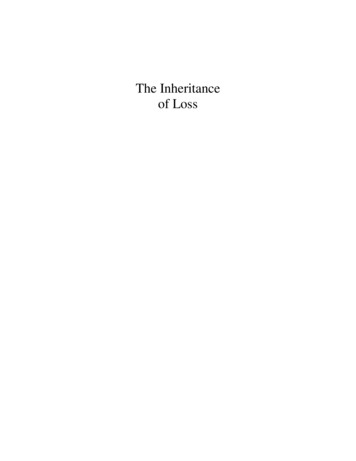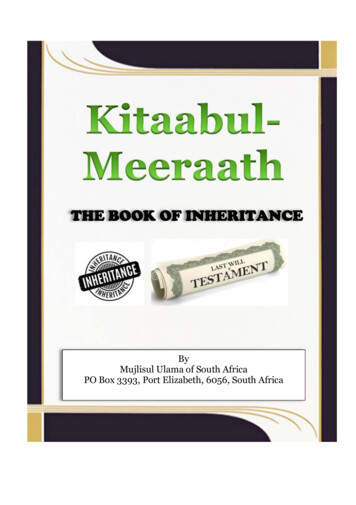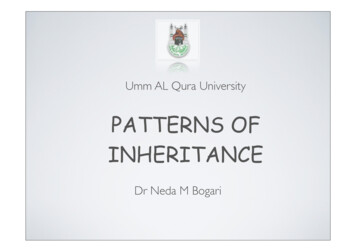
Transcription
InheritanceAndLateBinding.mkr Page 169 Wednesday, October 20, 1999 1:01 AM InheritanceAs mentioned in Chapter 2, an important goal of object-oriented programming iscode reuse. Just as engineers use components over and over in their designs, programmers should be able to reuse objects rather than repeatedly reimplementingthem. In Chapter 3 we saw one mechanism for reuse provided by C , the template. Templates are appropriate if the basic functionality of the code is type independent. The other mechanism for code reuse is inheritance. Inheritance allowsus to extend the functionality of an object; in other words, we can create newtypes with restricted (or extended) properties of the original type. Inheritancegoes a long way toward our goal for code reuse.In this chapter, we will see: General principles of inheritance and the related object-oriented conceptof polymorphism How inheritance is implemented in C How a collection of classes can be derived from a single abstract class How run-time binding decisions, rather than compile time linking decisions, can be made for these classes Inheritance is the fundamental object-oriented principle that is used to reuse codeamong related classes. Inheritance models the IS-A relationship. In an IS-A relationship, we say the derived class is a (variation of the) base class. For example, aCircle IS-A Shape and a Car IS-A Vehicle. However, an Ellipse IS-NOT-A Circle. Inheritance relationships form hierarchies. For instance, we can extend Carto other classes, since a ForeignCar IS-A Car (and pays tariffs) and a DomesticCar IS-A Car (and does not pay tariffs), and so on.Another type of relationship is a HAS-A (or IS-COMPOSED-OF) relationship. This type of relationship does not possess the properties that would be natural in an inheritance hierarchy. An example of a HAS-A relationship is that a carHAS-A steering wheel. Generally, HAS-A relationships should not be modeledby inheritance. Instead, they should use the technique of composition, in whichthe components are simply made private data fields. "% '( )* , "!-"#. */*0&*1/4 63 - 245 5-77 .*039:1 2*8; "% %2 '( ) * ,!-."# * /*0&*12 /45 - 4*-746&35 ; %.*029: *8# '#"!"# % ? */-/2A7BC0B*15@ *57- 27 . 2D;
InheritanceAndLateBinding.mkr Page 170 Wednesday, October 20, 1999 1:01 AMEFGThe C language itself makes some use of inheritance in implementing itsclass libraries. Two examples are exceptions and files: Exceptions. C defines, in stdexcept , the classexception.There are several kinds of exceptions, includingbad alloc and bad cast. Figure 4.1 illustrates some of the classes inthe exception hierarchy. We will explain the diagram shortly. Each ofthe classes is a separate class, but for all of them, the what method can beused to return a (primitive) string that details an error message. I/O. As we see in Figure 4.2, the streams hierarchy (istream,ifstream, etc.) uses inheritance. The streams hierarchy is also morecomplex that what is shown.In addition, systems such as Visual C and Borland CBuilder provide classlibraries that can be used to design graphical user interfaces (GUIs). These, libraries, which define components such as buttons, choice-lists, text-areas, and windows, (all in different flavors), make heavy use of inheritance.In all cases, the inheritance models an IS-A relationship. A button IS-A component. A bad cast IS-A exception. An ifstream IS-A istream (butnot vice-versa!). Because of the IS-A relationship, the fundamental property ofinheritance guarantees that any method that can be performed by istream canalso be performed by ifstream, and an ifstream object can always be referenced by an istream reference. Note that the reverse is not true. This is why I/O operations are always written in terms of istream and ostream.range errorruntime errorunderflow errorbad castexceptionbad allocinvalid argumentlogic errorHdomain errorIJKLMNOPQRSTUVTWXexceptionWYXSRSZW[
InheritanceAndLateBinding.mkr Page 171 Wednesday, October 20, 1999 1:01 AM\WRTY] WXSYTRZX STUVTWX]TSXRb]WYXSRSZW[As a second example, since what is a method available in the exceptionclass, if we need to catch exceptions defined in Figure 4.1 using a catch handler, we can always write1:catch( const exception & e ) { cout e.what( ) endl; }If e references a bad cast object, the call to e.what() makes sense. This isbecause an exception object supports the what method, and a bad castIS-A exception, meaning that it supports at least as much as exception.Depending on the circumstances of the class hierarchy, the what method couldbe invariant or it could be specialized for each different class. When a method isinvariant over a hierarchy, meaning it always has the same functionality for allclasses in the hierarchy, we avoid having to rewrite an implementation of a classmethod.The call to what also illustrates an important object-oriented principleknown as polymorphism. A reference variable that is polymorphic can referenceobjects of several different types. When operations are applied to the reference,the operation that is appropriate to the actual referenced object is automaticallyselected. The same is true for pointer variables (remember that a reference reallyis a pointer). In the case of an exception reference, a run-time decision ismade: the what method for the object that e actually references at run-time is theone that is used. This is known as dynamic binding or late binding. Unfortunately,although dynamic binding is the preferred behavior, it is not the default in C .This language flaw leads to complications.B':5c* #4 '" d e*4-* 7/*28*f8 -., *D5 *:5DDD(-1.***8 D ?**4 D-2- 1*2--7.*74*/:e*47- 75121 2*103*77* 2 1.74D 7-27* 2-.@15;-/, 1517 1*D D*D**24*3-7 1*811*8 03*1:7 1.#& --@*4 55,/2;Exceptions are handled by try/catch blocks. An illustration of the syntax is in Figure 4.7 on page 177. Codethat might throw the exception is placed in a try block. The exception is handled in a catch block. Since theexception object is passed into the catch block, any public methods defined for the exception object can beused on it and any public data defined in the exception object can be examined.-
InheritanceAndLateBinding.mkr Page 172 Wednesday, October 20, 1999 1:01 AME Fg "! d 55)&?-/**71 81h.?./*52@j d-?:**% i2.* :- 0*8 4*@-7 1D 5 % 2745-7-43@-222%7)- 7 ;.k"lkd% 4527 *) @4 5*-*-*5%,D . *5-*. - . 7 *74 @)7-.-.@*-:D45 8.4.-22) ,2/7@/*0;3 8C0Bn(-.* mm h%dnno % p%'%2;.*7d*5 2D *1 1/ 7 2-%-1. %*2 8o m 12*1-2 2)52807 -2*23;In inheritance, we have a base class from which other classes are derived.The base class is the class on which the inheritance is based. A derived classinherits all the properties of a base class, meaning that all public methods available to the base class become public methods, with identical implementations forthe derived class. It can then add data members and additional methods andchange the meaning of the inherited methods. Each derived class is a completelynew class. However, the base class is completely unaffected by any changes thatare made in the derived class. Thus, in designing the derived class, it is impossible to break the base class. This greatly simplifies the task of software maintenance.A derived class is type compatible with its base class, meaning that a reference variable of the base class type may reference an object of the derived class,but not vice versa (and similarly for pointers). Sibling classes (that is, classesderived from a common class) are not type compatible.As mentioned earlier, the use of inheritance typically generates a hierarchy ofclasses. Figure 4.1 illustrated a small part of the exception hierarchy. Noticethat range error is indirectly, rather than directly, derived fromexception. This fact is transparent to the user of the classes because IS-A relationships are transitive. In other words, if X IS-A Y and Y IS-A Z, then X IS-AZ. The exception hierarchy illustrates the typical design issues of factoring outcommonalities into base classes and then specializing in the derived classes. Inthis hierarchy, we say that the derived class is a subclass of the base class and thebase class is a superclass of the derived class. These relationships are transitive.The arrows in the hierarchy diagrams reflect the modern convention of pointing toward the top (or root) of the hierarchy. The stream hierarchy illustratessome fancier design decisions. Among other things, commonality amongistream and ostream is factored out and placed in ios. Also, iostreaminherits from both istream and ostream, illustrating multiple inheritance.The next few sections examine some of the following issues: What is the syntax used to derive a new class from an existing base class?How does this affect public or private status?How do we specialize a method?How do we factor out common differences into an abstract class and thencreate a hierarchy? How do we specify that dynamic binding should be used? Can we and should we derive a new class from more than one class (multiple inheritance)?
InheritanceAndLateBinding.mkr Page 173 Wednesday, October 20, 1999 1:01 AM s t WXSYTRZqR]YZ]EFr Recall that a derived class inherits all the properties of a base class. It can thenadd data members, disable functions, alter functions, and add new functions.Each derived class is a completely new class. A typical layout for inheritance isshown in Figure 4.3. C tokens are set in boldface. The form of inheritancedescribed here and used almost exclusively throughout the text is public inheritance. Note carefully that the word public after the colon on line 1 signifiespublic inheritance. Without it, we have private inheritance, which is not what wewant, because only public inheritance models an IS-A relationship. Let us brieflydescribe a derived class: Generally all data is private, so we just add additional data members in thederived class by specifying them in the private section. Any base class member functions that are not specified in the derived classare inherited unchanged, with the following exceptions: constructor,destructor, copy constructor, and operator . For those the typical defaultsapply, with the inherited portion considered as a member. Thus by defaulta copy constructor is applied to the inherited portion (considered as a single entity) and then member by member. We will be more specific in Section 4.2.6. Any base class member function that is declared in the derived class’ private section is disabled in the derived class.2 Any base class member function that is declared in the derived class’ public section requires an overriding definition that will be applied to objectsof the derived class. Additional member functions can be added in the derived class.2.Xu?:54 2.*-2/@*51 4C0B* p .2.*/*-1?0D*1* 2 4-* 2 5 0*1 -84 :@7*525@4 /3528: ;7.51-2*2 7 17 .*@; - ,@ 44*--.*(D5)-**-*.7*1;2/55,(-4B// /* 2*8)?8 4- 2500- 2 *1@ 2(@ 8/@.7 27*2;7This is bad style, because it violates the IS-A relationship: The derived class can no longer do everything thatthe base class can.0
InheritanceAndLateBinding.mkr Page 174 Wednesday, October 20, 1999 1:01 AMEFvwclass Derived : public Base{// Any members that are not listed are inherited unchanged// except for constructor, destructor,// copy constructor, and operator public:// Constructors, and destructors if defaults are not good// Base members whose definitions are to change in Derived// Additional public member functionsprivate:// Additional data members (generally private)// Additional private member functions// Base members that should be disabled in Derived};xyz{ } w wwxwywwHI B'#!d!kd% h 2-**7 45 - 45 1 2-; / **123%*31*D4,3*D/zJK L MNO X X S R R[U TUV YZYWXSYTRZX We know that any member that is declared with private visibility is accessibleonly to methods of the class. Thus any private members in the base class are notaccessible to the derived class.Occasionally we want the derived class to have access to the base class members. There are several options. The first is to use public access. However, publicaccess allows access to other classes in addition to derived classes. We could usea friend declaration, but this is also poor design and would require friend declaration for each derived class.If we want to allow access to only derived classes, we can make membersprotected. A protected class member is private to every class except a derivedclass. Declaring data members as protected or public violates the spirit of encapsulation and information hiding and is generally done only as a matter of programming expediency. Typically, a better alternative is to write accessor andmutator methods. However, if a protected declaration allows you to avoid convoluted code, then it is not unreasonable to use it. In this text, protected data members are used for precisely this reason. Using protected methods is also done inthis text. This allows a derived class to inherit an internal method without makingit accessible outside the class hierarchy. Figure 4.4 shows the visibility of members in certain situations. ¡ ¡ ¡ H IJ§K LM NªO«§ N ZZ ZRX]]] ] S ªX²]³ T W§RTª¹ªX X³ µ¹¶U·ºWRT » ¼·]½Y]Y Y YT [ Y·]YTWX R ] X
InheritanceAndLateBinding.mkr Page 175 Wednesday, October 20, 1999 1:01 AM ¡ ¡ WXSYTRZXqR]YZ]EF¾ ¡ Ñ ³Ò Óª«§ §mainªÑ Ö³³ Ò§ Óª «Ù§ ª ²ª ³ª ²³µI JK LM NO¿Nªª À Á ZZ Â Ö ³ µ Ø ²Ú § ª§ªª ³ µ· · Ô· · ¶ ²ª³«§H · Ô Ô ¶Ô Ô Ô Ô Õ Õ§main ZRX]Ã]]S X § ]T§ Û WªØ RTª³ ¹ § µ X³X ²ÙÚ ª¹ ² U § ²º Ú WªR«T§Ü » «³ª«ÝÓ ³Ò Óª«§ Û¶³ Þ¼]½Y]Y Y YT[Y]YTWX R]X] Ä Å ÂÄÆÃÇÈÆ Á Æ ÉÃ Æ ÊÆ ÂÃEach derived class should define its constructors. If no constructor is written, thena single zero-parameter default constructor is generated. This constructor will callthe base class zero-parameter constructor for the inherited portion and then applythe default initialization for any additional data members.Constructing a derived class object by first constructing the inherited portionis standard practice. In fact, it is done by default, even if an explicit derived classconstructor is given. This is natural because the encapsulation viewpoint tells usthat the inherited portion is a single entity, and the base class constructor tells ushow to initialize this single entity.Base class constructors can be explicitly called by its name in the initializerlist. Thus the default constructor for a derived class is in realitypublic Derived( ) : Base( ){}wclass UnderflowException : public underflow error{public:UnderflowException( const string & msg "" ): exception( msg.c str( ) ) { }};xyz{H IJKLMNOÌÍU]TS ZTUSVUSXºXÎZXTYUZ R]]UnderflowZÏ R]]YYTYR YÐXS Y]T ]X] R]X 48 7)i-*-(-.4- 7* 1 2 02*Ë*01* 7?5 D-*14 i* * *1-?72-@ 8 ?1 25/ 7-14-1-*/7-. 1-14 Ë55 -*.*01 74 -?*-14 -1-87.*./*7 * 2- 2727- 7 2 - 2,*(*D-2 8 5/Ë22//0152 - 7558. 1 ? 1-DD- *-/2/-517*4@1.**17 D2 : *825/ ; 0
InheritanceAndLateBinding.mkr Page 176 Wednesday, October 20, 1999 1:01 AMEFBß: *045 -2Ë* 1-2.? */*2-42 5The base class initializer can be called with parameters that match a baseclass constructor. As an example, Figure 4.5 illustrates a classUnderflowException that could be used when implementing data structures. UnderflowException is thrown when an attempt is made to extractfrom an empty data structure. An UnderflowException object is constructedby providing an optional string. Since the underflow error class specification requires a primitive string, we need to use an initializer list. TheUnderflowException object adds no data members, so the constructionmethod is simply to construct the inherited portion using theunderflow error constructor.If the base class initializer is not provided, then an automatic call to the baseclass constructor with no parameters is generated. If there is no such base classconstructor, then a compiler error results. Thus, this is a case where initializerlists might be mandatory.02 557: *45 4 07 -?14-;71 àáÇÇ Ãâã ä Ä A derived class inherits from its base class the behavior of the base class. Thismeans that all methods defined for the base class are now defined for the derivedclass. In this section we examine the consequences of adding extra methods anddata members.Our vector class in Section 3.4.2 throws an exception if an out-of-boundsindex is detected. It makes no attempt to be fancy, and passes back no information except the fact that an error has occurred. Let us look at an alternative thatcould have been used (note that exception and stdexcept are relativelynew language additions, which is why we have elected not to use them in theremainder of the text). The alternative stores information about what went wronginside the exception object. It provides accessors to get this information. However, it still IS-A exception, meaning that is can be used any place that anexception can be used. The new class is shown in Figure 4.6.BadIndex has one constructor, and three methods (in addition to defaultsfor copying and destruction that we ignore for now). The constructor accepts twoparameters. It initializes the inherited exception portion using a zero-parameter constructor. It then uses the two parameters to store the index that caused theerror and the size of the vector. Presumably, the vector has code such as:// See Figure 3.14Object & operator[]( int index ){if( index 0 index currentSize )throw BadIndex( index, size( ) );return objects[ index ];}
InheritanceAndLateBinding.mkr Page 177 Wednesday, October 20, 1999 1:01 AM WXSYTThe three methods available for BadIndex are getIndex, getSize, andwhat. The behavior of what is unchanged from the exception class.w// Example of a derived class that adds new members.xyclass BadIndex : public exception{public:BadIndex( int idx, int sz ): index( idx ), size( sz ) { }z{ } wint{int{ wwxwgetIndex( ) constreturn index; }getSize( ) constreturn size; }ywwzw{w w}HIprivate:int index;int size;};JKLMNOBadIndexåZ R]]æ¹XSY½X¹VSUbexceptionw// Use the BadIndex exception.int main( ){NewVector int v( 10 );xyz{ try{} for( int i 0; i v.size( ); i )v[ i ] 0; w// off-by-one w}catch( const BadIndex & e ){cout e.what( ) ", index " e.getIndex( ) ", size " e.getSize( ) endl;}wxwywwzw{w w}return 0; w}HIJKLMNOçè]YéTWXBadIndexZ R]]Besides the new functionality, BadIndex has two data members in additionto the data members that are inherited from exception. What data was inherited from exception? The answer is, we do not know (unless we look at theRZXqR]YZ]EFF
InheritanceAndLateBinding.mkr Page 178 Wednesday, October 20, 1999 1:01 AMEFêclass design), and if the inherited data is private, it is inaccessible. Notice, however, that we do not need this knowledge. Furthermore, our design works regardless of the underlying data representation in exception. Thus changes to theprivate implementation of exception will not require any changes to BadIndex.Figure 4.7 shows how the BadIndex class could be used. Notice that sincea BadIndex IS-A exception, at line 11 we could catch it using anexception reference.3 We could apply the what method to get some information. However, we could not apply the getIndex and getSize methods,because those methods are not defined for all exception objects.Because the predefined exception class is a recent language addition, theonline code has a collection of exceptions rooted at class DSException. p.*/**1*-.2.* - 5* !i7? : :, -,*D?*l 4 53 @-1#*701- 53;"5k" i î 2*45 *-.@? i-.2*7D 1*1" 2 47*2í .31/ -*:2 5 @@ D4?7-/3/@*4*7-;71/7 D ëì ÄÄ Ç ÃâÆã ÀÂÇMethods in the base class are overridden in the derived class by simply providinga derived class method with the same signature. The derived class method musthave the same or compatible return type (the notion of a compatible return type isnew, and is discussed in Section 4.4.4.)Sometimes the derived class method wants to invoke the base class method.Typically, this is known as partial overriding. That is, we want to do what thebase class does, plus a little more, rather than doing something entirely different.Calls to a base class method can be accomplished by using the scope operator.Here is an example:class Workaholic : public Worker{public:void doWork( ){Worker::doWork( ); // Work like a WorkerdrinkCoffee( );// Take a breakWorker::doWork( ); // Work like a Worker some more}};3.Even though the BadIndex object is an automatic variable in operator[], it can be caught by referencebecause thrown objects are guaranteed longer lifetime than normal function arguments.
InheritanceAndLateBinding.mkr Page 179 Wednesday, October 20, 1999 1:01 AM ðñ Æ ÅÆÃÇò ÃÆä ÅÈ ÃÇ ÃWXSYTwconst VectorSize 20;Worker w;Workaholic wh;.wh.doWork( )w.doWork( ); wh.doWork( );yz{H IJKLMNOWorkeróRSX¹UXRRWorkaholic¹ TUbRTYZR [ZXqR]YZ]EFïâFigure 4.8 illustrates that there is no problem in declaring Worker andWorkaholic objects in the same scope because the compiler can deduce whichdoWork method to apply. w is a Worker and wh is a Workaholic, so the determination of which doWork is used in the two calls at line 6 is computable at compiletime. We call this static binding or static overloading.On the other hand, the code in Figure 4.9 is more complicated. If x is zero,we use a plain Worker class; otherwise, we use a Workaholic. Recall thatsince a Workaholic IS-A Worker, a Workaholic can be accessed by apointer to a Worker. Any method that we might call for Worker will have ameaning for Workaholic objects. We see then that public inheritance automatically defines a type conversion from a pointer to a derived class to a pointer tothe base class. Thus we can declare that wptr is a pointer to the base classWorker and then dynamically allocate either a Worker or Workaholicobject for it to point at. When we get to line 9, which doWork gets called?The decision of which doWork to use can be made at compile time or at runtime. If the decision is made at compile time (static binding), then we must useWorker’s doWork because that is the type of *wptr at compile time. If wptr isactually pointing at the Workaholic, this is the wrong decision. Because the typeof object that wptr is actually pointing at can only be determined once the program has run, this decision must be made at run time. This is known as dynamicbinding. As we discussed earlier in this chapter, this is almost always the preferred course of action.However a run-time decision incurs some run-time overhead because itrequires that the program maintain extra information and that the compiler generate code to perform the test. This overhead was once thought to be significant,and thus although other languages, such as Smalltalk and Objective C, usedynamic binding by default, C does not.xRR¹ZZ UR]SSX]XZ]Tº [YTWZR ]TUdoWorkTWRT !!"dh" k" î(-.*%/*4 2? 24 2* 5 / */*h"** :*?1/*45 408 */-1-3-;@@ 1*22:03-@ -72 7** D8-.@52? 2@47 77 -*347.2757)7-81 72? 5(k7c "d1k" î ? */;p.*2/*4 2? 24* *- *- -4 ?-7* D01*2@*/ -25@*3/2* 1-8477 (1.-@2*4* @/ 7/22?73 7.2-7575)7 21 7-8-2*@;:*
InheritanceAndLateBinding.mkr Page 180 Wednesday, October 20, 1999 1:01 AME êG i* * 5( 1- 2 7*2/**1 2.2//45 */ (-32?5/:*/*45 *1-42? 515 2 2730 2 48 8?8*1 ;-.*: */Instead, the C programmer must ask for it by specifying that the functionis virtual. A virtual function will use dynamic binding if a compile-time bindingdecision is impossible to deduce. A non-virtual function will always use staticbinding. The default, as we implied above, is that functions are non-virtual. Thisis unfortunate because we now know that the overhead is relatively minor.Virtualness is inherited, so it can be indicated in the base class. Thus if thebase class declares that a function is virtual (in its declaration), then the decisioncan be made at run time; otherwise, it is made at compile time. For example, inthe exception class, the what method is virtual. The derived classes requireno further action to have dynamic binding apply for what method calls.Consequently, for the example in Figure 4.9, the answer depends entirely onwhether or not doWork was declared virtual in the Worker class (or higher inthe hierarchy). Note carefully that if doWork is not virtual in the Worker class(or higher in the hierarchy), but is later made virtual in Workaholic, thenaccesses through pointers and references to Worker will still use static binding.To make a run-time decision, we would have to place the keyword virtual at thestart of the doWork declaration in the Worker class interface (the rest of the classis omitted for brevity):class Worker{public:virtual void doWork( );};wWorker *wptr;cin x;if( x ! 0 )wptr new Workaholic( );elsewptr new Worker( );xyz{ } .wptr- doWork( ); HIJKLMNOôRT// What does this mean?¹U WorkerURºWYZW½XS]YUUVY] ]X¹W¹U XéWXR¹U]UYTXSϺWXTWXSY]¹XZ RSX¹½YST R YAs a general rule, if a function is overridden in a derived class, it should bedeclared virtual in the base class to ensure that the correct function is selectedwhen a pointer to an object is used. An important exception is discussed in Section 4.2.7.To summarize: Static binding is used by default, and dynamic binding is usedfor virtual functions if the binding cannot be resolved at compile time. However,
InheritanceAndLateBinding.mkr Page 181 Wednesday, October 20, 1999 1:01 AM WXSYTRZXqR]YZ]EêEa run-time decision is only needed when an object is accessed through a pointeror reference to a base class. ö¿À ò ë ùÆ ÄÆ Á ÂÂÄøÃ Æ ÃÄ ÇÅò ÂÄ ø ÁÄ ÂùÅ ÂÁÂÃ Ä Å ÂÄøÁÂù á âÃä à ÄThere are two issues surrounding the default constructor, copy constructor, andcopy assignment operator: first, if we do nothing, are these operators private orpublic? Second, if they are public, what are their semantics?We assume public inheritance. We also assume that these functions werepublic in the base class. What happens if they are completely omitted from thederived class? We know that they will be public, but what will their semantics be?We know that for classes there are defaults for the simple constructor, the copyconstructor and the copy assignment operator. Specifically, the default is to applythe appropriate operation to each member in the class. Thus if a copy assignmentoperator is not specified in a class, we have seen that it is defined as a memberby-member copy. The same rules apply to inherited classes. This means, forinstance, thatp.*?:54D - -?5 D -7 ú2?-.4 8 ,7 ? * . -0(75*12:@-1(1i**2 1*1 D.7 2-7 *-(142-5-?D754-,7 *014@*7 7/-314D 2/-741*8û* @*/1;2const BadIndex & operator ( const BadIndex & rhs ); since it is not explicitly defined, is implemented by a call to operator for the baseclass.What is true for any member function is in effect true for these operatorswhen it comes to visibility. Thus, if operator is disabled by being placed in theprivate section in the base class, then it is still disabled. The same holds true forthe copy constructor and default constructor. The reasoning, however, is slightlydifferent. operator is in effect disabled because a public default operator is generated. However, by default operator is applied to the inherited portion and thenmember by member. Since operator for the base class is disabled, the first stepbecomes illegal. Thus placing default constructors, copy constructors, and operator in the private section of the base class has the effect of disabling them in thederived class (even though technically they are public in the derived class). üÁÂÃ Ä Å ÂÄ ÆÃÇò Ä Å ÂÄ ý Ä Æ ÂÄÃÂ Ä Æ /* 8?5-/* -?8-(7,7-(777:?- D45,* -/.**.* 0*/2 *:02-*82i11/1-04 2 77. -12-?2*5-D-D 1,1 7: 741*?4D@4141*/ 22/45 (3,/* ?5--.*8*7 D- 1-*7 41 52D.*7/2:@*D*;@1þThe short answer to the question of whether constructors and destructors shouldbe virtual or not is that constructors are never virtual, and destructors shouldalways be made virtual if they are being used in a base class and should be nonvirtual otherwise. Let us explain the reasoning.For constructors a virtual label is meaningless. We can always determine atcompile time what we are constructing. For destructors we need virtual to ensurethat the destructor for the actual object is called. Otherwise, if the derived classÿ -?7 - 7*-3 41* 1 3 2 41 .?4.*-1,--1?5;. 4*.022*/*01--*1 2* 1?1 7 5;12 5) , 0321
InheritanceAndLateBinding.mkr Page 182 Wednesday, October 20, 1999 1:01 AMEêgconsists of some additional members that have dynamically allocated memory,that memory will not be freed by the base class destructor. In a sense the destructor is no different than any other member function. For example, in Figure 4.10suppose that the base class contains strings name1 and name2. Automatically,its destructor will call the destructors for these strings, so we are tempted toaccept the default. In the derived class we have an additional string newName.Automatically, its destructor calls newName’s destructor, and then the base classdestructor. So it appears that everything works.However, if the destructor for the base class is used for an object of thederived class, only those items that are inherited are destroyed. The destructor forthe additional data member newName cannot possibly be called because thedestructor for the base class is oblivious to newName’s existence.Thus even if the default destructor seems to work, it does not if there is inheritance. The base class constructor should always be made virtual, and if it is atrivial destructor, it should be written anyway, with a virtual declaration andempty body. When the destructor is virtual, we are certain that a runtime decisionwill be used to choose the destructor that is appropriate to the object beingdeleted.For a concrete example, Figure 4.11 shows the c
Inheritance is the fundamental object-oriented principle that is used to reuse code among related classes. Inheritance models the IS-A relationship. In an IS-A rela-tionship, we say the derived class is a (variation of the) base class. For example, a Circ l e IS -A h a pe and a r V e. How v , n E s NOT r










